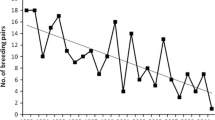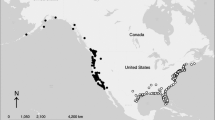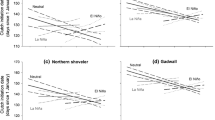Abstract
As many seaduck populations around the world have been reported to be in decline, there is an increasing demand for knowledge about intrinsic and extrinsic factors determining population dynamics of these species. In this study, we analyzed long-term dynamics of the summer population of Velvet Scoters (Melanitta fusca) breeding in the Åland archipelago in the Baltic Sea; in particular, we examined the influence of winter weather and density dependence on population change. The studied population exhibited substantial fluctuations but only a weak negative trend during the total period of 58 years (1949–2007), and no significant trend at all during the latter three decades of the study (1977–2007). We tested for density dependence and incorporated the winter North Atlantic Oscillation index into the model to test for effects of winter conditions. Our final model explained 56.3 % of the variance of population growth of the studied population. Delayed density dependence explained 29.7 %, pre-breeding climate 8.3 %, and post-breeding climate 18.3 % of the variance. That breeding success is density dependent in a delayed manner is in accordance with the apprehension that Velvet Scoters breed at the age of 2 years. We conclude that density dependence and winter conditions must be taken into consideration when discussing population changes in seaducks in general and the Velvet Scoter in particular.
Zusammenfassung
Trend und Populationsdynamik einer Samtentenpopulation ( Melanitta fusca ): Einfluss von Dichteabhängigkeit und Winterklima
Weltweit gehen zahlreiche Populationen von Meeresenten im Bestand zurück. Deshalb benötigen wir mehr Einsicht, wie intrinsische und extrinsische Faktoren die Populationsentwicklung dieser Arten bestimmen. In dieser Studie wurden Langzeittrends einer Brutpopulation von Samtenten (Melanitta fusca) untersucht, die auf den Ålandinseln in der Ostsee brüten. Wir haben insbesondere die Einflüsse von Winterwetter und Dichteabhängigkeit auf die Populationsentwicklung untersucht. Es waren beträchtliche Fluktuationen, aber nur ein schwacher negativer Trend in der gesamten Zeitspanne von 58 Jahren (1949–2007) und kein Trend in den letzten drei Jahrzehnten (1977–2007) der Studie zu beobachten. Mit einem Populationsmodell haben wir auf Dichteabhängigkeit getestet und untersucht, ob der Winter-NAO-Index im Modell als Indikator für Winterwetter einen Einfluss auf die Populationsentwicklung der Samtenten hat. Das beste Modell erklärt 56.3 % der Varianz im Wachstum der untersuchten Population. Verzögerte Dichteabhängigkeit erklärt 29.7 %, das Klima vor der Brutzeit 8.3 % und Klima nach der Brut 18.3 % der Varianz. Das Ergebnis, dass Bruterfolg verzögert dichteabhängig war, steht in Übereinstimmung mit der Hypothese, dass Samtenten im Alter von zwei Jahren beginnen zu brüten. Dichteabhängigkeit und Winterwetter sind also bei der Betrachtung der Populationsentwicklung von Meeresenten im Allgemeinen und Samtenten im Speziellen zu berücksichtigen.



Similar content being viewed by others
References
Alisauskas RT, Taylor JJ, Swoboda CJ, Kehoe FP (2004) Components of population growth rate for white-winged scoters in Saskatchewan, Canada. Anim Biodivers Conserv 27:451–460
Almaraz P, Amat JA (2004) Multi-annual spatial and numeric dynamics of the white-headed duck Oxyura leucocephala in southern Europe: seasonality, density dependence and climate variability. J Anim Ecol 73:1013–1023
Andersson Å, Lindgren P-O, Staav R (1978) Linjetaxeringar av sjöfågel under häckningstid i Stockholms skärgård 1937–1938 och 1973–1974. Vår Fågelvärld 37:209–223
Berndt RK, Hario M (1997) Velvet scoter. In: Hagemeijer WJ, Blair MJ (eds) The EBCC atlas of European breeding birds. Poyser, London
Blums P, Nichols JD, Hines JE, Mednis A (2002) Sources of variation in survival and breeding site fidelity in three species of European ducks. J Anim Ecol 71:438–450
Brown PW (1981) Reproductive ecology and productivity of white-winged scoters. PhD thesis, University of Missouri, Columbia
Brown PW, Fredrickson LH (1989) White-winged scoter, Melanitta fusca, populations and nesting on Redberry Lake, Saskatchewan. Can Field Nat 103:240–247
Brown PW, Houston CS (1982) Longevity and age of maturity of white-winged scoters. J Field Ornithol 53:53–54
Caughley G (1970) Eruption of ungulate populations, with emphasis on Himalayan thar in New Zealand. Ecology 51:53–72
Caughley G (1976) Wildlife management and the dynamics of ungulate populations. In: Coaker PH (ed) Applied biology, vol 1. Academic, Waltham, pp 183–246
Coulson JC (1984) The population dynamics of the eider duck Somateria mollissima and evidence of extensive non-breeding by adult ducks. Ibis 126:525–543
Coulson JC (2010) A long-term study of the population dynamics of common eiders Somateria mollissima: why do several parameters fluctuate markedly. Bird Study 57:1–18
Cramp S, Simmons KEL (1977) The birds of the western Palearctic, vol 1. Oxford University Press, Oxford, pp 644–650
Dementev GP, Gladkov NA (1952) Birds of the Soviet Union, vol. 4. Israel program for Scientific Translation, Jerusalem 1967, pp 599–604
Dennis B, Taper ML (1994) Density dependence in time series observations of natural populations: estimation and testing. Ecol Monogr 64:205–224
Durinck J, Skov H, Andell P (1993) Seabird distribution and numbers in selected offshore parts of the Baltic Sea, winter 1992. Ornis Svec 3:11–26
Elmberg J, Nummi P, Pöysä H, Sjöberg K (2003) Breeding success of sympatric dabbling ducks in relation to population density and food resources. Oikos 100:333–341
Elmberg J, Folkesson K, Guillemain M, Gunnarsson G (2009) Putting density dependence in perspective: nest density, nesting phenology, and biome, all matter to survival of simulated Anas platyrhynchos nests. J Avian Biol 40:317–326
Grenquist P (1951) On the recent fluctuations in numbers of waterfowl in the Finnish archipelago. Proc Int Ornithol Congr 10:494–496
Grenquist P (1952) Recent changes in the populations of the eider, Somateria m. mollissima, and the velvet scoter, Melanitta f. fusca, in the Finnish archipelago. Pap Game Res 8:81–100 (In Swedish with English summary)
Grenquist P (1965) Changes in abundance of some duck and sea bird populations off the coast of Finland. Finnish Game Res No. 27
Gunnarsson G, Elmberg J (2008) Density-dependent nest predation—an experiment with simulated mallard nests in contrasting landscapes. Ibis 150:259–269
Gunnarsson G, Elmberg J, Sjöberg G, Pöysä H, Nummi P (2004) Why are there so many empty lakes? Food limits survival of mallard ducklings. Can J Zool 82:1698–1703
Gunnarsson G, Elmberg J, Sjöberg G, Pöysä H, Nummi P (2006) Experimental evidence for density dependent survival in mallard (Anas platyrhynchos) ducklings. Oecologia 149:203–213
Hario M, Rintala J (2006) Fledgling production and population trends in Finnish common eiders (Somateria mollissima mollissima)—evidence for density dependence. Can J Zool 84:1038–1046
Hario M, Komu R, Muuoronen P, Selin K (1986) Population trends among archipelago birds in Söderskär bird sanctuary 1963–1986. Suomen Riista 33:79–90 (In Finnish with English summary)
Hario M, Mazerolle MJ, Saurola P (2009) Survival of female common eiders Somateria m. mollissima in a declining population in the northern Baltic Sea. Oecologia 159:747–756
Hartman G (1994) Long-term population development of a reintroduced beaver (Castor fiber) population in Sweden. Conserv Biol 8:713–717
Hartman G (2003) Irruptive population development of European beaver in southwest Sweden. Lutra 46:103–108
Hengeveld R (1989) Dynamics of population invasions. Chapman and Hall, London
Hurrell JW, Deser C (2010) North Atlantic variability: the role of the North Atlantic Oscillation. J Mar Syst 79:231–244
Johnston CA, Naiman RJ (1990) Aquatic patch creation in relation to beaver population trends. Ecology 71:1617–1621
Jónsson JE, Gardarsson A, Gill JA, Petersen A, Gunnarsson TG (2009) Seasonal weather effects on the common eider, a subarctic capital breeder, in Iceland over 55 years. Clim Res 38:237–248
Källander H (1996) Skrattmåsens Larus ridibundus populationsutveckling i Sverige under de senaste 25 åren. Ornis Svec 6:5–16
Kehoe FP, Brown PW, Houston CS (1989) Survival and longevity of white-winged scoters nesting in central Saskatchewan. J Field Ornithol 60:133–288
Kölzsch A, Sæther SA, Gustafsson H, Fiske P, Höglund J, Kålås JA (2007) Population fluctuations and regulation in great snipe: a time series analysis. J Anim Ecol 76:740–749
Koskimies J (1955) Juvenile mortality and population balance in velvet scoter (Melanitta fusca) in Maritime conditions. Proc Int Ornithol Congr 11:476–479
Koskimies J (1957) Polymorphic variability in clutch size and laying date of velvet scoter, Melanitta fusca (L.). Ornis Fenn 34:118–128
Koskimies J, Lahti L (1964) Cold-hardiness of the newly hatched young in relation to ecology and distribution in ten species of European ducks. Auk 81:281–307
Larsson K, Forslund P (1994) Population dynamics of barnacle goose Branta leucopsis in the Baltic area: density dependent effects on reproduction. J Anim Ecol 63:954–962
Lehikoinen A, Kilpi M, Öst M (2006) Winter climate affects subsequent breeding success of common eiders. Glob Change Biol 12:1355–1365
Meijer T, Drent RH (1999) A re-examination of the capital and income in breeding birds. Ibis 141:399–414
Merikallio E (1958) Finnish birds, their distribution and numbers. Fauna Fenn 5:1–181
Mikola J, Miettinen M, Lehikoinen E, Lehtilä K (1994) The effects of disturbance caused by boating on survival and behaviour of velvet scoter Melanitta fusca ducklings. Biol Conserv 67:119–124
Murray DL, Anderson MG, Steury TD (2010) Temporal shift in density dependence among North American breeding duck populations. Ecology 91:571–581
Newton I (1998) Population limitation in birds. Academic, London
Nordberg M (2002) Population development and estimated size of the breeding population of velvet scoters (Melanitta fusca) at the Åland islands during the latter part of the 20th century. Report no 91, Department of Conservation Biology, Swedish University of Agricultural Sciences, Uppsala
Nordström M, Högmander J, Nummelin J, Laine J, Laanetu N, Korpimäki K (2002) Variable responses of waterfowl breeding populations to long-term removal of introduced mink. Ecography 25:385–394
Nummi P, Saari L (2003) Density-dependent decline of breeding success in an introduced, increasing mute swan Cygnus olor population. J Avian Biol 34:105–111
Pannekoek J, van Strien A (2005) TRIM 3 manual (Trends and indices for Monitoring data). Statistics Netherlands, Voorburg
Parker H, Holm H (1990) Patterns of nutrient and energy expenditure in female common eiders nesting in the high arctic. Auk 107:660–668
Rintala J, Tiainen J (2004) Population trends of spring hunted sea ducks in the southern Finnish archipelago 1997–2004. Suomen Riista 50:65–75 (in Finnish)
Rönkä MTH, Saari CLV, Lehikoinen EA, Suomela J, Häkkilä K (2005) Environmental changes and population trends of breeding waterfowl in northern Baltic sea. Ann Zool Fenn 42:587–602
Rothery P, Newton I, Dale L, Wesolowski T (1997) Testing for density dependence allowing for weather effects. Oecologia 112:518–523
Royama T (1992) Analytical population dynamics. Population and community biology series 10. Chapman and Hall, London
Seavy NE, Reynolds MH, Link WA, Hatfield JS (2007) Postcatastrophe population dynamics and density dependence of an endemic island duck. J Wildl Manag 73:414–418
Skov H, Heinänen S, Zydelis R, Bellebaum J, Bzoma S, Dagys M, Durinck J, Garthe S, Grishanov G, Hario M, Kieckbusch JJ, Kube J, Kuresoo A, Larsson K, Luiguoje L, Meissner W, Nehls HW, Nilsson L, Petersen IK, Roos MM, Pihl S, Sonntag N, Stock A, Stiepniece A, Wahl J (2011) Waterbird populations and pressures in the Baltic Sea. Nordic Council of Ministers, Copenhagen. TemaNord 2011:550
Stenseth NC, Ottersen G, Hurrel JW, Mysterud A, Lima M, Chan KS, Yoccoz NG, Ådlandsvik B (2003) Studying climate effects on ecology through the use of climate indices, the North Atlantic oscillation, El Nino Southern Oscillation and beyond. Proc R Soc Lond B 270:2087–2096
Sugiura N (1978) Further analysis of the data by Akaike’s information criterion and the finite corrections. Communications in statistics, Theory and Methods, A7
Svensson S, Svensson M, Tjernberg M (1999) Svensk fågelatlas. SOF, Stockholm (in Swedish)
Swedish Environmental Protection Agency (1978) Biologiska inventeringsmetoder, BIN-Fåglar. Punkt-linjetaxering (in Swedish)
Taylor D (1970) Growth, decline, and equilibrium in a beaver population at Sagehen Creek. PhD thesis, University of California, Berkeley
Traylor JJ, Alisaukas RT (2006) Effects of intrinsic and extrinsic factors on survival of white-winged scoter (Melanitta fusca deglandi) ducklings. Auk 123:67–81
Traylor JJ, Alisauskas RT, Kehoe FP (2004) Nesting ecology ofwhite-winged scoters (Melanitta fusca deglandi) at Redberry Lake,Saskatchewan. Auk 121:950–962
Viksne J, Janaus M, Stipniece A (1996) Recent trends in the black-headed gull Larus ridibundus population in Latvia. Ornis Svec 6:39–44
Viljugrein H, Stenseth NC, Smith GW, Steingbakk GH (2005) Density dependence in North American ducks. Ecology 86:245–254
Author information
Authors and Affiliations
Corresponding author
Additional information
Communicated by F. Bairlein.
Rights and permissions
About this article
Cite this article
Hartman, G., Kölzsch, A., Larsson, K. et al. Trends and population dynamics of a Velvet Scoter (Melanitta fusca) population: influence of density dependence and winter climate. J Ornithol 154, 837–847 (2013). https://doi.org/10.1007/s10336-013-0950-7
Received:
Revised:
Accepted:
Published:
Issue Date:
DOI: https://doi.org/10.1007/s10336-013-0950-7




